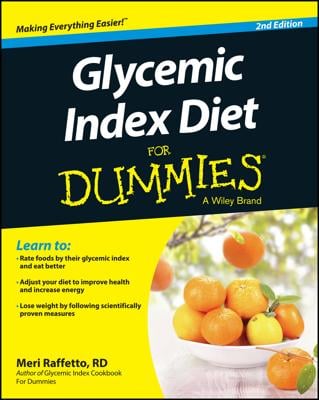The goal of healthy eating on a low-glycemic diet is to balance your food choices every day, even when your days are hectic. You don’t have to eat all low-glycemic carbs all the time, but aim for choosing them most of the time (meaning at least one low-glycemic food per meal) while balancing your intake of medium- to high-glycemic foods. You can stay on track whether you’re at home, on vacation, or out to lunch with friends.
To help make choosing low-glycemic foods easier, use these tips:
Get acquainted with the glycemic index list: The glycemic index list is your starting point because it can familiarize you with what foods have a low, medium, and high glycemic index. You’ll need to focus at first to pick up on which foods are low-glycemic and which ones are medium- and high-glycemic, but soon you’ll have memorized the glycemic nature of the foods you eat the most and you won’t need to depend on the list as much. For listing information, go to the Web site of the Glycemic Index Foundation.
Pay attention to portion sizes: Following the low-glycemic list of foods is simply following a low-glycemic diet. Following a low-glycemic diet for weight loss requires closer attention to the all-important portion size. Even if you’re regularly choosing low-glycemic foods and balancing them with medium- and high-glycemic foods, if you don’t pay attention to your portion sizes, you may never lose weight. Here’s why:
The glycemic load of a food typically increases when you eat larger amounts.
Your calorie level for the day is determined mostly by the portion sizes you eat.
You can generally gauge that if a food’s glycemic load is very low, it likely won’t go up too much if you decide to eat more of that food. If the glycemic load is near medium or already in the medium category, then it’ll go up from there.
You can retrain your brain to recognize appropriate portion sizes of different foods for calorie control. Use the following table as a general reference for scaling back your brain’s mental image of the appropriate portion size:
| Food Category | Recommended Portion Size for Various Items |
|---|---|
| Grains | 1 slice of bread 1/2 of an English muffin, hamburger bun, or bagel 1/2 cup of cooked cereal, pasta, or other cooked grain 1/3 cup of rice 3/4 cup of cold cereal One 6-inch tortilla |
| Other starchy carbohydrates | 1/2 cup of beans (which have a small amount of protein) 1/2 cup of lentils (which also have a small amount of protein) |
| Fruits | 1 medium piece 1/2 cup canned or sliced 6 ounces (3/4 cup) 100% fruit juice |
| Vegetables | 1 cup raw 1/2 cup cooked 6 ounces (3/4 cup) 100% vegetable juice |
| Dairy or soy products | 8-ounce cup of milk or yogurt 1/3 cup of cottage cheese 1 ounce of cheese |
| Proteins | 1/2 cup of beans (which are also high in carbs) 3 to 4 ounces (the size of a deck of cards) of beef, poultry, pork, or fish 1 ounce of cheese 1 egg 1 ounce of nuts 1 tablespoon of nut spread (such as peanut or almond butter) |
| Fats | 1/8 (2 tablespoons) of avocado 1 teaspoon of oil, butter, margarine, or mayonnaise 2 teaspoons of whipped butter 8 olives 1 tablespoon of regular salad dressing 2 tablespoons of lowfat salad dressing |
A good exercise to help you get your portion sizes under control is to measure your food for one day so you can see what the actual portion sizes look like on your plate. You don’t have to be perfect and measure your food every day (that’s no way to live your life). Measuring your food for just one day gives you enough of an idea of how much to put on your plate.
Strive to consume a maximum glycemic load of 25 per meal. Doing so allows you a good variety of carbohydrates for your meal including grains, vegetables, fruits, and/or dairy products. If you’re not sure what the estimated glycemic load of your favorite foods are, browse to Nutrition Data and enter the name of the food in the Search box.

